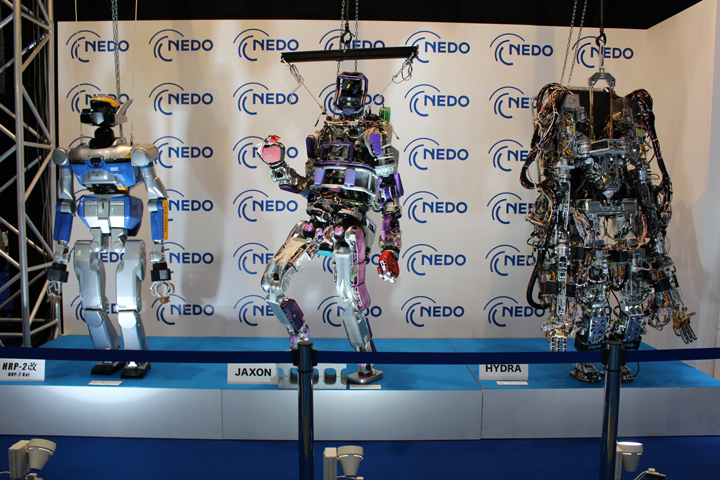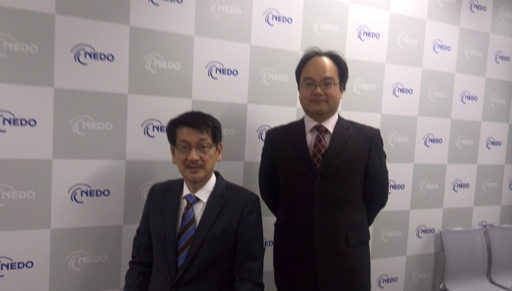Many robotic competitions in the world including DARPA and JVRC have a homogeneous goal: to significantly impact the human society by their contributions.
Japan Virtual Robotic Challenge - Fostering Innovation
Junko Nirmala Interviews Satoshi Kochiyama | Japan Virtual Robotic Challenge
The desire for being competitive and become identified through competitions has become a vital drive of mankind. The international competitions in every sector be it sports, art or science, schools, colleges, research organizations companies do bring out the best possible announcements for each competitions held everywhere in the world.Speaking of Robot competitions, challenges the platforms to solve the problems and foster innovations are ever increasing .According to the list of the robot competitions, maintained by R. Steven Rainwater (2004), there were dozens of events running each month all around the world.
As robotics industry is developing in the speed that mankind is yet to understand the full scope, the more complicated and sophisticated robot competitions, contests have appeared. At the beginnings, the main task was just to construct a robot. Nowadays, massive data processing from sensors is required and very complex and sophisticated algorithms for robot decisions are involved. Although the contest rules are very different, we can see some common features. The easiest categories use very strictly defined environment of the event – typically a maze.
One such competition this year was the Japan Virtual Robotic challenge featuring the most difficult simulations and the Competition winners had to perform live in the Japan Robot Exhibition [IREX]. The Most watched, highly attractive demonstration at IREX- 2015 was the NEDO`s JAXON, Hydra and Hydra2-Kai. In this interview we talked with Mr. Satoshi Kochiyama Program Manager of Japan Virtual Robotic challenge at NEDO.

Please Introduce Japan virtual robot competition.
The social infrastructures in Japan will turn half a century old; as such, appropriate measures are necessary to avoid mishaps and collapse of the social infrastructures. In addition, aging maintenance workers in Japan and the minimal of skill transfer to the younger workers would cause many problems of infrastructure in time to come. During a disaster, rapid restorations are hard to achieve as it would be time-consuming to conduct emergency inspection of the social infrastructures. Hence, this resulted in a research and development project to promote the use of robots to social infrastructure. Hence to bring out some good inventions in social infrastructure Japan Virtual Robotics Challenge (JVRC) “is a project organized by New Energy and Industrial Technology Development Organization (NEDO).and Ministry of Economy, Trade and Industry focusing on a very unique outcome as the disaster response robot by computer simulation.
What are tasks for the competition participants and how the outcome is managed.
The tasks involves conducting virtual visual inspections of cracks and tunnel walls and roads, conducting a hammering tests, long distance navigation, vehicle inspection, traversing obstacles, vehicle inspection using tools, securing routes and lastly supporting fire extinguishing. Ranking and scoring is judged based on the total time to accomplish the task. Penalties are also given for mistakes on targets investigated. This competition kick-started at the end of March 2015 by releasing the terms and rules of the competition and accepting applications, this was followed by the submission of examination documents by July 11th 2015 the preliminary rounds of the competition was conducted in October at CEATEC Japan.
In IREX-2015 the talk of the event was Jaxon, HRP-2 Kai. The winners of JVRC-2015 had worked on these robots, it was impressive crowd to watch the demos of these robots in function, and how this happened.
A.The JVRC is a competition for the computer simulation of disaster response robots and in the competition, robot models being developed through NEDO projects as well as independently-developed robot models will compete using the robot simulator “Choreonoid” to see how many work tasks associated with disaster sites they can complete. JVRC`s schedule and plan was such that the top performers win the right to implement their software on the real robots and demonstrate at iREX 2015 (International Robot Exhibition 2015).
This year, the winning team was MID from MID Academic Promotion who also bagged the JVRC Award with a total score of 270.6. This was followed by TEAMNADO from Osaka Prefecture University College of Technology with a score of 126. And finally, the third placing went to ODENS-B from Osaka Electro-Communication University who scored a total of 94. So the simulators developed by Winning teams were applied to JAXON, Hydra and HRP-2 KAI
Robot (JAXON) has been developed by Jouhou System Kougaku (JSK) laboratory, the University of Tokyo. Technology for this robot is based on the recent research of high-speed and high-torque motor driver with water-cooling system, RTM-ROS inter-operation for intelligent robotics, and generation of full-body fast dancing motion, due to the generic 10 year's research of HRP-2 as a platform humanoid robot. The target for this development is the robot support in a variety of unsafe human tasks tele operated by humans in case of a disaster, equipped with body structure capability for use of human devices and tools in human environment, performance for dynamic full-body actions covering human-sized speed and power, and basic function for intelligent and integrated robot platform system for performing various tasks independently.
HRP-2 is a humanoid robot developed in the Japanese national project "Humanoid Robotics Project (HRP)"(METI/NEDO, FY1998-2002). The robot was developed by Kawada Industries, Inc., AIST, Yaskawa Electric and Shimizu Corporation. HRP-2Kai is its improved version for DARPA Robotics Challenge (DRC). Its legs and arms are extended in order to walk on rough terrain including large gaps and to improve its manipulation ability. Joint configurations of writes are modified and sensors including a LRF and cameras are added. Since the robot was designed more than ten years ago, its electronics system became old and it was difficult to use the latest computers. To cope with this issue, its internal electronics system is fully re-designed. Although its exterior looks similar to the original one, HRP-2Kai is almost a newly designed robot.
DARPA competition has attracted many innovators around the world, is there any future plans to invite international engineers, innovators to Japans Robotic challenge platform.
Robots will become increasingly important in all aspects of life. That they and their computers will be able to self-program and build robots even better than themselves is a distinct possibility. Many robotic competitions in the world including DARPA and JVRC have a homogeneous goal: to significantly impact the human society by their contributions. The influence of an established robotics competition on youngsters are enabling an huge impact on learning of technology, engineering, their attitudes towards science, mathematics, and 21century workplace skills.

Mr.Satoshi and team
JVRC is open for all Participants from throughout world and open for collaborations all details are in JVRC website.
Junko Nirmala is a Tokyo resident with 17 years of Professional experience in Technology and business consulting services. Her diverse background includes Advisory assignments completed for 70 plus Japanese companies on Globalization, Founder of startup company in Green Technology, conducting Training and seminars for Global Workforce in Japan and so on. Currently she is involved in Promoting Japan Robots Industry. She has authored 3 books and consistently writes for newspapers and magazines in Japan.
The content & opinions in this article are the author’s and do not necessarily represent the views of RoboticsTomorrow
Featured Product

